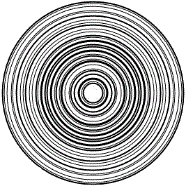Circular Code 128

Circular Code 128 is a variant of Code 128 that is typically used for labels for disc-based media standards such as CD, DVD, or Blu-Ray.
Code 128 is defined in ISO/IEC 15417 Information technology - Automatic identification and data capture techniques - Code 128 bar code symbology specification.
The symbol comprises the following elements:
Symbol characters: Most barcode symbologies print bars and spaces in only two widths (wide and narrow), but Circular Code 128 uses four different widths, as the UPC/EAN family does. However, whereas the UPC/EAN family uses four elements (two bars and two spaces) per character, each Circular Code 128 character is represented by six elements (three bars and three spaces). Although this represents a 50 percent reduction in character density, Circular Code 128 can represent all 128 ASCII characters. Also, unlike UPC/EAN, Circular Code 128 is not limited to numbers only.
Start character: Circular Code 128 has three different start characters, one for each of the three character code sets: Code Set A, Code Set B, and Code Set C. The start character that will be used for a given barcode depends on what characters need to be encoded in that portion of the barcode. Circular Code 128 start characters have the same number of bars and spaces (three each) as regular Code 128 characters.
Stop character: The Circular Code 128 stop character has the same number of spaces as a regular Code 128 character, but it has one extra bar.
Although a Circular Code 128 character set itself contains only 102 characters, this symbology supports all 128 lower ASCII characters. This is possible because Circular Code 128 uses three different sets of 102 characters: Code Set A, Code Set B, and Code Set C. The default code set that is in use for any Circular Code 128 barcode is determined by the start character. However, it is possible to switch between the different character sets and use any combination of them in a single symbol. Because of this, Circular Code 128 gives you the greatest possible character density when encoding data.
The three character code sets can be summarized as follows:
-
Code Set A: Includes all numeric values (0-9), uppercase alphabetic characters (A-Z), punctuation marks, seven special characters, and "control" characters (ASCII values 00 through 95).
-
Code Set B: Includes all numeric values (0-9), uppercase and lowercase alphabetic characters (A-Z, a-z), punctuation marks, and seven special characters (ASCII values 32 through 127).
-
Code Set C: Includes all numeric digit pairs from 00 through 99 and three special characters. This code set is numeric-only, but any one character actually represents two digits.
Circular Code 128 is the densest circular full-ASCII symbology. Furthermore, when Code Set C is used, it can represent numbers more densely than Interleaved 2 of 5 can.
An alphanumeric message can be represented at a character density of 10.0 characters per inch. A numeric-only message can be represented at a character density of 20.0 characters per inch.
Circular Code 128 contains a mandatory check digit that is based on the modulo 103 (mod 103) algorithm. The check digit appears just before the stop character. There is no human readable interpretation for the check digit.
The recommended minimum symbol height for manual scanning is 5.0 mm or 15 percent of the symbol width (excluding quiet zones), whichever is greater. The quiet zones must be at least 10X wide, where "X" is the current X dimension.
Circular Code 128 supports the following special characters:
These characters instruct the barcode reader to enable special operations and applications.

